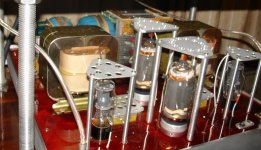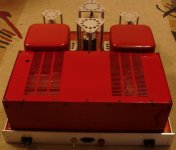I have almost completed this GK-71 based SE amp, and it sounds better to me than my previous GM-70 SE, 6G-B8 PP, 2C4C SE (these tubes are 2A3 substitutes). G-411 (rare old tubes) are at the driver stage, and 6P9 - at input stage. All tubes are in triode mode, and are quite powerful. Some advantages of GK-71 against GM-70 are: lower Ri (internal resistance) around 1k4 vs 1k7 for GM-70, and, it sounds good starting from 800V, while GM-70 needs 1200V.
The input stage is made as a separate case with volume control (actually as preamp).
The input stage is made as a separate case with volume control (actually as preamp).
Attachments
Nice work!
With Va = 800V you can use an output Transformer impedance less than 6-7KΩ ? This could be another advantage.
With Va = 800V you can use an output Transformer impedance less than 6-7KΩ ? This could be another advantage.
I have not tested, actually I used 9K (with impedance of PMC EB1i speakers taken as 3,6 Ohms). I measured frequency dependence of impedance vs frequency with good immittance meater, and it is near 3,6 Ohms within 50...200 Hz. Output trafos are similar to those for GM-70, turns ratio n1/n2 near 50. The core is 40cm2 (50x80mm), made locally (vertical and horizontal sectioning, 4 prim + 3 sec vertically, 2 sections horizontally). The last is very useful for lowering dynamic capacitance.
When I looked passband, at 10Hz I saw only some phase shift (amplitude still the same visually), at highs -1dB is near 30kHz.
GK-71 cathode is on the ground via 1 Ohm control resistor, negative grid bias around 120V, plate voltage near 850V, plate current 110mA.
G-411 cathode is biased by 5W 20V zener at high enough current (near 40mA), shunted by lytic and film caps and silver-mica caps.
6P9 cathode is biased by 1W 6V zener, without shunting (this zener has relavely low noise).
All plate voltages are from separate trafos, finally filtered by mosfet source followers, with good film and silver-mica caps shunting near tube sockets.
For GK-71 filament heating I used 24V-15A SMPS, coolers are taken off since one uses only 3A, and excessive 4v (20V are needed for filament) are damped by 5-stages RC filtering for ripples elimination. Again, filament rails are shunted by film + silver-mica caps near tube sockets.
Signal to noise ratio obtained is very good, nothing is heared from speakers. Acoustic background is very "dark" during pauses.
When I looked passband, at 10Hz I saw only some phase shift (amplitude still the same visually), at highs -1dB is near 30kHz.
GK-71 cathode is on the ground via 1 Ohm control resistor, negative grid bias around 120V, plate voltage near 850V, plate current 110mA.
G-411 cathode is biased by 5W 20V zener at high enough current (near 40mA), shunted by lytic and film caps and silver-mica caps.
6P9 cathode is biased by 1W 6V zener, without shunting (this zener has relavely low noise).
All plate voltages are from separate trafos, finally filtered by mosfet source followers, with good film and silver-mica caps shunting near tube sockets.
For GK-71 filament heating I used 24V-15A SMPS, coolers are taken off since one uses only 3A, and excessive 4v (20V are needed for filament) are damped by 5-stages RC filtering for ripples elimination. Again, filament rails are shunted by film + silver-mica caps near tube sockets.
Signal to noise ratio obtained is very good, nothing is heared from speakers. Acoustic background is very "dark" during pauses.
Last edited:
very excellent!
Dear VladimirK,
the pics of your finished amp are excellent looking and indicate great craftsmanship! Congratulations!!
The color combination of the wood and the metal looks very nice to me. I like it.
Due to your initial post I ordered some GK-71's (not yet arrived) -despite having already some GM70's- because your mentioning of a B+ below 1kV seemed attractive to me. So, one day I'll build a GK-71 SE too.
Ulrich
Dear VladimirK,
the pics of your finished amp are excellent looking and indicate great craftsmanship! Congratulations!!
The color combination of the wood and the metal looks very nice to me. I like it.
Due to your initial post I ordered some GK-71's (not yet arrived) -despite having already some GM70's- because your mentioning of a B+ below 1kV seemed attractive to me. So, one day I'll build a GK-71 SE too.
Ulrich
Thanks, Ulrich, I find this design solution quite convenient (though at a limit of acceptable size), instead of multi-floor or separated cases designs. At least, I needed much less efforts with cases, as compared to previous separate blocks with GM70.
G2 at plate and G3 at cathode, or G2 and G3 at plate GK71?
Directly or via a resistor (grid-stoper)?
Directly or via a resistor (grid-stoper)?
Hi,
In the GK71 the G2/G3 are fully apart/separated as in the EL34?
The GK71 have a top antennae conected to the plate or something.
It is a plate output as the topcap from the 805?
Or just a heat sink?
Thanks
In the GK71 the G2/G3 are fully apart/separated as in the EL34?
The GK71 have a top antennae conected to the plate or something.
It is a plate output as the topcap from the 805?
Or just a heat sink?
Thanks
Wow great, thaks for inform.
How we can manipulate it as the Decware Rachel EL34?
How is the GK71 with 800V?
How we can manipulate it as the Decware Rachel EL34?
How is the GK71 with 800V?
People say, that, with G3 at plate, GK71 gets bad linearity, although Ri becomes even lower. 800V are good for GK71. Main difficulty is almost the same as with GM70 - big and expensive output trafos.
Major justification for using such tubes - a case when they have to struggle with big and "difficult" speakers (PMC EB1i in my case). Now I am very impressed with bass and other ranges, although listened to many SS amps in my system before (Yamaha B2-x and Restek, for instance).
What is the coupling between G411 and GK71? Interstage transformer or capacitor?
Please talk about your 6P9 preamplifier(input stage), thanks!
Please talk about your 6P9 preamplifier(input stage), thanks!
These stages are capacitor coupled. And the plate load of G411 is assembled from nine 2W S2-10 resistors, this load dissipates around 12W power, and one can see two aluminum covers with holes over these resistors, for better air flow.
Please talk about your 6P9 preamplifier(input stage), thanks!
The metal case 6P9 tubes are rather linear and sound quite good in triode mode, if one provides good quality resistive load and interstage caps.
I used cathode positive voltage bias by decent 6V zener. One should prefer a zener with low differential resistance (i.e. with good voltage stability at varying current). At this voltage range, zeners show not a big noise, and could be used without capacitive shunting.
Voltage control is assembled as L-pad on the basis of soviet military 12-position P2K rotary switch (it has a bulk gold-palladium contact ring).
I'll try to find the pre and the power units circuits among the old files. But, what I would like to stress, there are many specific things at assembling definite unit, that are not reflected in a circuit, and difficult to describe them in brief.
Among them, every cap or resistor shown in a circuit, in my case represent an assembly, and one should design every assembly with definite recipes, accounting both types of parts, their values, mutual location and leakage fields, which part is closer to tube socket, etc. In resistor assemblies, the rules of shunting are also valid, like with capacitors.
Among them, every cap or resistor shown in a circuit, in my case represent an assembly, and one should design every assembly with definite recipes, accounting both types of parts, their values, mutual location and leakage fields, which part is closer to tube socket, etc. In resistor assemblies, the rules of shunting are also valid, like with capacitors.
- Status
- Not open for further replies.
- Home
- Amplifiers
- Tubes / Valves
- GK-71 SE amp



